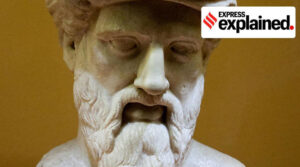JULY 19, 2022

A POSITION paper by the Karnataka government on the National Education Policy (NEP) 2020, uploaded recently, has revived discussion on something that has long been known to historians of mathematics — that what we call the Pythagoras theorem was already known to Indians from the Vedic times.
The position paper, part of Karnataka’s submissions to the NCERT for a National Curriculum Framework, describes Pythagoras’s theorem as “fake news” and the “so-called Pythagoras theorem”.
“The Pythagoras theorem is disputed in many international forums. Not the content, but Pythagoras claiming it as his own… There are theories that say there was nobody called Pythagoras,” Madan Gopal, a retired IAS officer who heads Karnataka’s NEP task force, told The Indian Express. He referred to a text called the Baudhayana Sulbasutra, in which a specific shloka refers to the theorem.
Did Pythagoras exist, and what is the theorem named after him?
Mathematicians contacted by The Indian Express said the evidence suggests that the Greek philosopher (around 570–490 BC) did exist. However, there is an element of mystery around him, largely because of the secretive nature of the school/society he founded in Italy. Relatively little is known about his mathematical achievements, because there is nothing today of his own writings (History of Mathematics Archive, University of St Andrews, Scotland).
The Pythagoras theorem describes the relationship connecting the three sides of a right triangle (one in which one of the angles is 90°):
a² + b² = c²
where a and b are the two perpendicular sides, and c is the length of the diagonal side.
If any two sides of a right triangle are known, the theorem allows you to calculate the third side. Extended to the sides of squares and rectangles and their diagonals, the equation is of immense importance in construction, navigation and astronomy.
How do we know that Indian mathematicians from the Vedic period knew this?
There are references in the sulbasutras, which are texts pertaining to fire rituals (yajanas) performed by Vedic Indians. The oldest of these is the Baudhayana Sulbasutra.
“The period of Baudhayana Sulbasutra is uncertain (as with other sulbasutras), there being no direct internal evidence useful in this respect. It is estimated based on linguistic and other secondary historical considerations and have varied substantially depending on the author. By and large, in recent literature, Baudhayana Sulbasutra is taken to be from around 800 BCE,” said mathematics professor Shrikrishna G Dani, currently with University of Mumbai-Department of Atomic Energy Centre for Excellence in Basic Sciences.
“It has been known for quite long in academic circles that Baudhayana Sulbasutra contains a statement of what is called Pythagoras theorem (it was known rather as a geometric fact, and not as a ‘theorem’),” said Professor Dani, who wrote a paper describing geometry in the sulbasutras in ‘Studies in History of Mathematics, Proceedings of Chennai Seminar’ in 2008.
Associate Professor Kim Plofker of Union College, New York, who specializes in the history of Indian mathematics, cited two of the sutras in the first chapter in the Baudhayana Sulbasutra: “The areas [of the squares] produced separately by the length and the breadth of a rectangle together equal the area [of the square] produced by the diagonal. This is observed in rectangles having sides 3 and 4, 12 and 5, 15 and 8, 7 and 24, 12 and 35, 15 and 36.”
In what context is this equation discussed in the sulbasutras?
The yajna rituals involved construction of altars (vedi) and fireplaces (agni) in a variety of shapes such as isosceles triangles, symmetric trapezia, and rectangles. The sulbasutras describe steps towards construction of these figures with prescribed sizes.
The Pythagorean equation comes into play in these procedures, which involve drawing perpendiculars. These perpendiculars, as detailed in Dani’s paper, were based on triangles whose sides were in the ratio 3:4:5 or 5:12:13. These sides follow the Pythagorean relation, because 3² + 4² = 5², and 5² + 12² = 13². Such combinations are called Pythagorean triples.
Did Indian mathematicians prove the equation?
There is no evidence that the Indians had a proof, nor even that Pythagoras did, Dani said. “The idea of a mathematical proof based on an axiomatic structure is unique to the Greeks — thus in respect of the other cultures, ‘proof’ of a geometrical statement only meant some means of carrying conviction, which would have been there in various cultures (since it is indeed not a ‘self-evident’ statement),” Dani said.
And Plofker said, by email: “Given the evident familiarity of the sulba-practitioners with geometric constructions, I take it as a given that they knew and understood geometric rationales supporting those ‘Pythagorean’ sutras.”
How did knowledge of the equation evolve?
The earliest evidence is from the Old Babylonian civilization (1900-1600 BCE). “They were well aware of Pythagoras’s theorem: but since that was more than a thousand years before Pythagoras, they did not call it that: they referred to it as the ‘Diagonal rule’. There are probably at least half a dozen tablets that establish that they knew this rule,” said Professor Norman Wildberger of the University of New South Wales, who has done extensive research on the clay tablet Plimpton 322.
The earliest evidence of a proof comes from a period after the sulbasutras. “The oldest surviving axiomatic proof of the theorem is in the Elements of Euclid from around 300 BCE. But again, it seems extremely likely that many more-or-less formal geometric rationales for the ‘Pythagorean’ relation were understood by many of its users long before Euclid recorded his rigorous-demonstration version,” Plofker said.
How relevant is the discussion on whether the Indians or Pythagoras knew the equation first?
The Indian Express put this question to Prof Dani. “The current debate is obviously on account of the position paper in Karnataka, where they irresponsibly call Pythagoras theorem ‘fake news’. There is an implicit claim of ownership, that is the thing that one needs to clarify,” Dani said.
“… This kind of attitude that everything was there in India, generally referred to as ‘Jagatguru syndrome’ — that needs to be countered. Some things are partially true, along with that a whole lot of garbage goes into the sense of cultural superiority, which is actually very detrimental. As long as we think that we are the masters, living in the past, the country is not going to make serious inroads into modern development,” he said.

































































































